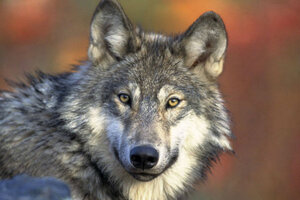America's lone wolf: Scientists say US has just one true wolf species
Eastern wolves, red wolves, gray wolves, and coyotes are all members of the same species, says a new study – a claim which could affect lupine conservation status.

This April 18, 2008, file photo provided by the U.S. Fish and Wildlife Service shows a gray wolf.
Gary Kramer/File/U.S. Fish and Wildlife Service/AP
The gray wolf is North America's only native wolf species, a new study concludes, overturning common understanding – and government conservation classification – of America's fabled moon-howlers.
Eastern and red wolves are actually the not-so-distant descendants of gray wolves and coyotes, rather than their own species, according to a Princeton-UCLA study published in Science Advances Wednesday. The scientists behind the research are calling for the US Fish and Wildlife Service to rethink its plan to delist the gray wolf as an endangered species this fall and to consider instead expanding its protection to hybrid species, which currently fall outside of the realm of government protection.
The research is being used as evidence by scientists who want the Endangered Species Act, which currently extends its financial and promotional punch only to pure species, extended to the offspring of cross-species mating.
“What’s very exciting about this paper is that it’s using extremely powerful tools to address longstanding, challenging questions in conservation,” Ryan Kovach, a research wildlife biologist at the United States Geological Survey who was not involved in the new study, told The New York Times.
Loss of habitat, conflicts with ranchers, and widespread hunting nearly wiped gray wolves out of the United States by the early 1900s. They gained protected status under the Endangered Species Act in 1973, but the US Fish and Wildlife Service's recognition of the eastern wolf as a separate species in 2013 prompted reconsideration of this status. If eastern wolves, rather than gray wolves, were the original predators to prowl America's east, then the phenomenon of the gray wolf exceeding its population recovery goals in the Western United States would be enough to take the wolf off the list.
Conservationists blocked this plan at the time, as the Times reported, and the new research suggests that the science behind the move to de-list was incorrect.
In their new study, researchers analyzed the complete genomes of 12 pure gray wolves (from regions without any coyotes), three pure coyotes (from regions without any gray wolves), 6 eastern wolves, and 3 red wolves. The results showed that eastern wolves are about 75 percent gray wolf and 25 percent coyote, while red wolves are about 25 percent gray wolf and 75 percent coyote – with almost no unique genetic material of their own.
Robert Wayne, an evolutionary biologist at UCLA and senior author on the study, told Los Angeles Times that coyotes began interbreeding with the gray wolf population in the Great Lakes area in the 1920s, and the mix resulted in the eastern wolf. And a few hundred years earlier, coyotes and gray wolves began to mate in the American South, giving rise to the red wolf.
Thought to be a distinct species, red wolves have benefited from protected status and millions of dollars spent on recovery programs – rebounding from complete extinction in the wild. But if they truly lack independent ancestry, as the new research suggests, they'll fall outside the US Endangered Species Act, which makes no mention of hybrids.
When the Endangered Species Act was adopted in the 1970s, biologists thought that inter-breeding among species was rare and led to unhealthy hybrids, but they now believe the opposite. Robert Wayne, a UCLA professor of evolutionary biology and senior author of the study argued in a press release that the Endangered Species Act should include some hybrids.
[Editor's note: This article has been corrected to reflect that Eastern and red wolves were descendants rather than ancestors of gray wolves and coyotes.]

